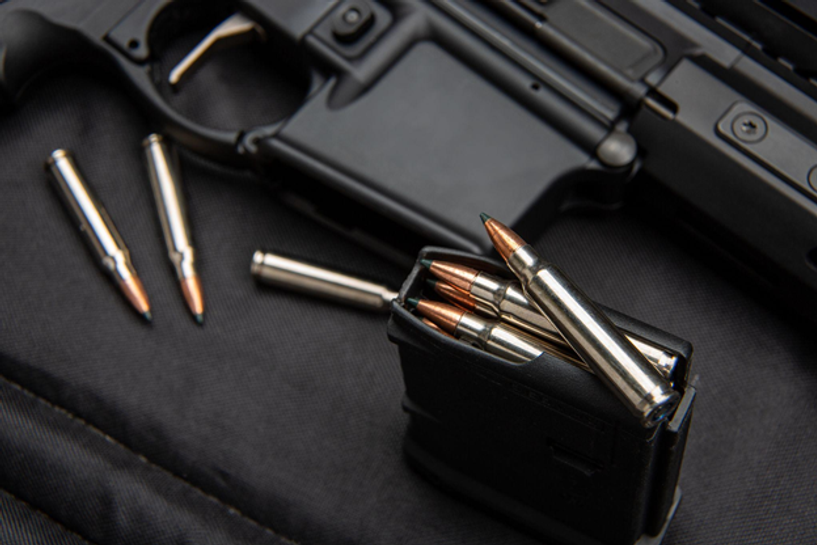If you’re looking at AR pistol uppers, choose your caliber wisely. Different calibers will perform differently out of a smaller, shorter upper, which is something you have to think about before you complete the build.
That being the case, we rounded up some of the most popular AR pistol chamberings and dropped them here. Check out the relative virtues of each before you buy.
.223 and 5.56
These are the “old reliable” cartridges paired with AR15 pistol uppers, often used simply because that’s what’s available. Plus, there are a lot of advantages associated with them.
Both of these cartridges:
- Are lightweight
- Readily available
- Cheap
- Easy to pack and carry
- Produce little recoil
- And offer a lot of use cases
Plus, if you choose an AR pistol upper chambered in either .223 or 5.56, you get the whole “rifle firepower in a pistol-sized package thing” which is one of the big selling points of an AR-15 pistol.
The one main drawback here is that, despite the many use cases, these cartridges don’t tend to perform well from a shorter barrel, and if you need better stopping power, there are better options, some of which will be explored below.
7.62 Soviet
This is one of the better cartridge options to look at if you want an AR pistol that offers greater stopping power than one chambered in 5.56 or .223.
The 7.62 Soviet will produce much greater stopping power at closer ranges, but it has abysmal performance at greater ranges, which shouldn’t be too much of a problem since AR pistols aren’t built for intermediate or long-range use anyway.
The other thing is that, like .223 and 5.56, the 7.62 Soviet cartridge is pretty widely available and also fairly affordable, so like the other two, you can keep costs somewhat low.
Of course, if you’re looking for something with these relative virtues and then some, what you should be looking at is a .300 Blackout upper.
.300 Blackout
The .300 Blackout is (sort of) a necked out 5.56 or .223 cartridge loaded with a .30 caliber bullet.
It produces higher stopping power than either the ..223 or 5.56, more comparable to the 7.62 Soviet, making it ideal for engagements at close ranges.
Also like the 7.62 Soviet, it produces terrible performance at greater ranges. But that shouldn’t be much of a concern here.
Here’s the real selling point, though. Many 5.56 and .223 parts are compatible with .300 BLK builds, and old 5.56 and .223 brass can potentially be resized and loaded at .300 BLK.
Moreover, .300 BLK performs exceptionally well from short barrels, probably better than any other option on this list. That makes it ideal in AR15 pistol uppers, as well as in suppressed platforms.
There are a few drawbacks, though. One is that it is sort of a niche cartridge that is not too easy to find. The other thing is that it is fairly expensive - so keep these things in mind.
9mm
For what it’s worth, 9mm is fairly common as an AR15 pistol upper chambering, despite the fact that it eliminates the whole “rifle firepower in a pistol footprint” dynamic. However, the popularity of PCCs warrants a slightly closer examination.
The 9mm Luger, even though it doesn’t produce the same stopping power of any of the three (technically four) rifle cartridges mentioned so far, still does a fair job up close, all while producing little recoil.
Plus, ammo is relatively cheap, easy to find, and if you have a 9mm handgun, you can potentially run the same ammo in both, keeping things easy.
There are also 9mm AR15 pistol uppers that are bufferless, so if you want you can skip the whole gas system and make a smaller, lighter, and more compact AR pistol.
.22LR

There are also .22LR AR15 pistol uppers out there, but there are some caveats to mention here.
One is that .22LR is severely anemic compared to the other cartridges here and will not produce anywhere near the stopping power. This significantly limits its utility as a defensive cartridge.
However, it’s a fun cartridge for plinking, and is light, cheap, universally available, and produces hardly any port pop, muzzle pop, or recoil. This also makes it good for smaller-framed, lighter, and beginner shooters.
If you do build an AR pistol with a .22LR AR pistol upper, just be aware that you should reserve it for shooting at the range. Its abilities as a defensive ARP will be highly limited.
That said, it’ll also produce such little recoil you can probably skip the whole AR pistol brace.
Shop AR Pistol Uppers and Braces Here
In the market for a new AR pistol upper for a micro ARP, or an AR pistol brace? We have the parts you need to customize your build the way you want. Check them out here and get in touch with us at Sales@MCSGearup.com if you have any questions.

